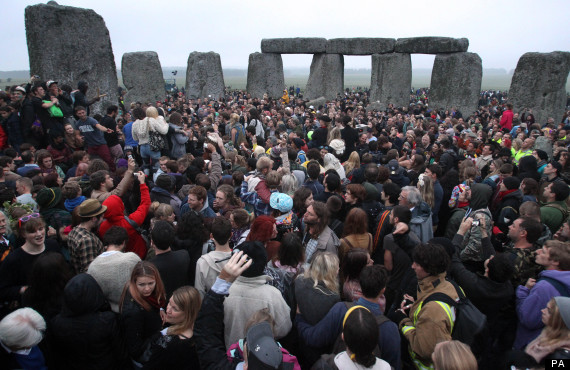Giant concert venue

(REX FEATURES)
A university professor with an expertise in sound (and who also happened to be a part-time DJ) said that he believed Stonehenge was created as a dance arena for listening to "trance-style" music.
Rupert Till said that the standing stones had the ideal acoustics to amplify a "repetitive trance rhythm".
He used a computer model to conduct experiments in sound, which he said revealed that the 5,000 year old monument may have been used for ancient raves.

A long barrow near the stone circle at Stonehenge (REX FEATURES)
Earlier this year archaeologists found that Stonehenge could have been a graveyard for a community of elite families.
The British team analysed the ancient remains of 63 bodies buried around Stonehenge, finding that the first monument was originally a graveyard for a community of elite families, whose remains were brought to Stonehenge and buried over a period of more than 200 years.
However the team also discovered that the earliest burials long predate the monument in its current form.
Health spa

In 2008 archaeologists Geoffrey Wainwright and Timothy Darvill said that there was evidence Stonehenge had been sought after by pilgrims for its healing properties.
They said that ancient chipping of the rocks helped to indicate that Stonehenge was the equivalent of Lourdes, a French commune framed for its supposed miraculous healing powers.
Wainwright and Darvill said that the state of skeletons which had been recovered from the area around Stonehenge, showed that many people were ailing when they went to the stone circle.
Team building exercise

Researchers from the University College London claimed that Stonehenge was built as part of an annual winter solstice ritual which resembled "Glastonbury festival and a motorway building scheme at the same time".
As many as 4,000 people may have gathered at the site each year, when the entire population numbered only tens of thousands.
Tests on remains found at the site revealed that people came to the site from as far as the Scottish Highlands at the same time every year to feast, and built the monument together.
Ancient calculator

In 1963 astronomer Gerald Hawkins proposed the theory that Stonehenge was a computer for predicting eclipses of the sun and moon.
He identified 165 key points in the Stonehenge complex and found that many of them very strongly correlated with the rising and setting positions of the sun and moon.
Stonehenge has long been studied for its connections with ancient astronomy. Some Archaeoastronomers have claimed that Stonehenge represents an "ancient observatory,"
Stonehenge has become an increasingly popular place for people to celebrate the summer solstice. However in 2005 findings indicated that our ancestors visited Stonehenge to celebrate the winter solstice.
Sex symbol

In 2003 a researcher at the University of British Columbia said that Stonehenge was, in fact, an ancient sex symbol constructed to look like the female sexual organ.
Anthony Perks said: "Stonehenge could represent, symbolically, the opening by which Earth Mother gave birth to the plants and animals on which the ancient people so depended."
Alien development

Swiss author Erich von Däniken claimed in his 1968 book Chariots of the Gods? that the technologies and religions of many ancient civilisations were given to them by extraterrestrials.
This influenced the building of Stonehenge as well as the Egyptian pyramids and Easter Island.
On his website Vin Daniken calls himself the "world's most successful non-fiction writer of all time". Others may disagree but he has sold over 65 million copies of his books worldwide.
Druid temple

Many believed that Stonehenge was a Druid temple in the 17th and 18th centuries after antiquary John Aubrey first proposed the theory.
According to English Heritage he surveyed Stonehenge in the late 17th century, and his studies of stone circles in other parts of Britain led him to conclude that they were built by the native inhabitants.
Since the Druids were the only prehistoric British priests mentioned in the classical texts, he attributed Stonehenge to the Druids.
It is now much more likely that Stonehenge predated the Druids by hundreds of years.
Source: By Lucy Kinder - http://www.telegraph.co.uk/news/picturegalleries/howaboutthat/10523016/Why-was-Stonehenge-built-The-eight-most-popular-theories.html
Stonehenge Tourist News














